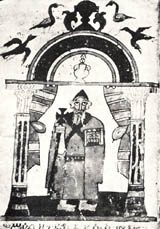Classic DACB Collection
All articles created or submitted in the first twenty years of the project, from 1995 to 2015.Iyasus-Moa (‘Iyäsus-Mo’a) (A)

‘Iyäsus-Mo’a, Abba, saint of the Ethiopian Church, was the founder and abbot of the monastery of St. Stephen in an island in Lake Hayq in Wällo. His name means “Jesus has won.” One of the most eminent personalities of Ethiopian monasticism, he was born, according to the Gädlä ‘Iyäsus-Mo’a composed in the fifteenth century, in Dahna, in Bägémder, to Zä-Krestos and ‘Egzi’e-Kebra. In his thirtieth year he went to the monastery of Däbrä Damo, where, after seven years of novitiate, he received the monastic habit and scapular from Abba Yohanni. He was then appointed abbot of the monastery of Däbrä Hayq by one of the kings of the Zagwé dynasty. He remained there for forty-four years, until his death. He is said to have been the spiritual father of St. Täklä-Haymanot, who stayed with him on the island for ten years.
Traditionally, ‘Iyäsus-Mo’a played a leading part in the restoration of the Solomonic dynasty in or about 1270: thanks to his help Emperor Yekuno-‘Amlak obtained the throne, in gratitude for which he endowed the monastery with privileges, including the gift to ‘Iyäsus-Mo’a’s disciple, Abba Zä-‘Iyäsus, of the office of ‘agabé sä’at and one-third of the property of the realm. In the fifteenth century, however, Däbrä Hayq lost its privileges; another tradition appeared, applying the historical role of ‘Iyäsus-Mo’a and the powers received by him to Täklä-Haymanot and the monastery of Däbrä Libanos of Šäwa, whose abbot stood at the head of the regular clergy.
In the list of the spiritual sons of ‘Iyäsus-Mo’a, figure the great names of Ethiopian monasticism: St. Täklä-Haymanot, Abba Bä-Sälotä-Mika’él, ‘Aron (Ecca-Aron of Däbrä Darét or Aron the Thaumaturge), and Abba Giyorgis of Gasecca. The Ethiopian Church commemorates ‘Iyäsus-Mo’a on 26 Hedar (5 December). The most famous of his mortifications was that for fifty years of his monastic life he did not sleep on his side, but in a sitting position, according to the rule of Pachomius.
Stanslaw Kur
Bibliography
S. Kur (ed. and trans.),Actes de Iyasus Mo’a, Corpus Scriptorum Christianorum Orientalium, Scriptores aethiopici, t. 49 and t. 50.
Conti Rossini, “La caduta della dinastia Zagué e la versione amarica del Be’ela Nagast,” Rendiconti della Reale Accademia dei Lincei, Vol. XXXI (1922): 279-314.
——–, “Il ‘Gadla Takla Haymanot’ secondo la redazione waldebbana,” Atti della Reale Accademia dei Lincei (1894), Series V, Vol. II(1896): 107, 133.
——–, “Il Gadla Filpos e il Gadla Yohannes di Dabra Bizan,” ibid., Vol. VIII (1903): 156 (plate 2).
——–, Storia d’Etiopia (Bergamo, 1928), 262, 284, 320 ff.
E. A. Wallis Budge, The Life and Miracles of Takla Haymanot (London, 1906), Vol. I, 167, 170, 176-8, 188-90; Vol. II, 68, 71, 76, 105, 262, 362.
——–,The Book of the Saints of the Ethiopian Church (Cambridge, 1928), Vol. I, 293; Vol. IV, 1244-5.
B. Turaiev, Acta Sancti aaronis,, Corpus Scriptorum Christianorum Orientalium, series altera, t. XX, 141, 158.
A. Caquot, “L’homélie en l’honneur de l’archange Ouriel,” Annales d’Ethiopie, Vol. I (1955): 68, 80.
I. Guidi, “Le synaxaire éthiopien, III, Mois de nahasê et de pâguemên,” Patrologia Orientalis IX, 474-6, [678-80].
P. Paez, Hisotoria Aethiopiae, in C. Beccari (ed.), Rerum Aethiopicarum Scriptores Occidentales (Roma, 1903-17), Vol. II, 518, 536, 566-9, 571 ff.
Enrico Cerulli, Storia della letteratura etiopica (Milano, 1961), 94-7.
——–, “Gli abbati di Dabra Libanos, capi del monachismo etiopico, secondo la lista rimata”,Orientalia, N. S. Vol. XII (1943): 229 ff.; Vol. XIII (1944): 145.
A. Pollera, Lo stato etiopico e la sua chiesa (Roma - Milano, 1926), 34-7, 177-81, 227, 231-3.
V. V. Bolotov in Khristianskoye Chtenye (Feb. 1898), 289-98.
Taddesse Tamrat, “The Abbots of Däbrä-Hayq 1248-1535,” Journal of Ethiopian Studies, Vol. VIII, No. 1 (1970).
——–, Church and State in Ethiopia 1270-1527 (Oxford, 1972), 67, 110, 112, 114, 158-67, 174, 177-8, 197, 203, 232.
This article is reproduced, with permission, from The Dictionary of Ethiopian Biography, Vol. 1 ‘From Early Times to the End of the Zagwé Dynasty c. 1270 A.D.,’ copyright © 1975, edited by Belaynesh Michael, S. Chojnacki and Richard Pankhurst, Institute of Ethiopian Studies, Addis Ababa, Ethiopia. All rights reserved.



